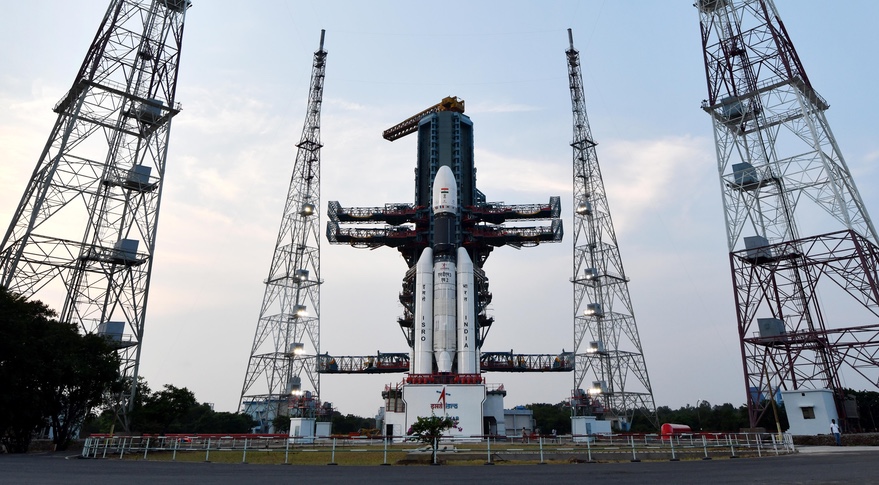WASHINGTON — The launch of a set of OneWeb satellites on an Indian rocket could be the harbinger of a greater role India will play in a commercial launch industry straining to satisfy demand.
A Geosynchronous Satellite Launch Vehicle (GSLV) Mark 3 rocket, also designated LVM3, is scheduled to launch from India’s Satish Dhawan Space Centre Oct. 22 at 2:37 p.m. Eastern carrying 36 OneWeb satellites. The launch is the first of two that the broadband satellite constellation company acquired from NewSpace India Ltd. (NSIL), the commercial arm of the Indian space agency ISRO, in the spring.
OneWeb turned to NSIL after terminating its contract for Soyuz launches in the wake of Russia’s invasion of Ukraine. OneWeb also signed a contract with SpaceX for three Falcon 9 launches to deploy the remainder of its first-generation satellite constellation.
OneWeb had few other options to consider given the current state of the launch market. Russia’s invasion of Ukraine had cut off access to the Soyuz as well as Proton, a vehicle that was once a major player in the commercial launch market but which had fallen out of favor in recent years. The remaining Ariane 5 and Atlas 5 vehicles have all been sold, while new vehicles like Ariane 6, H3, New Glenn and Vulcan Centaur have suffered delays that have pushed back first launches, once projected for as soon as 2020, to 2023 or beyond.
Exacerbating the problem is surging demand from megaconstellations, including an order by Amazon in April for more than 80 Ariane 6, New Glenn and Vulcan Centaur launches for its Project Kuiper system. That order alone absorbed much of the available capacity in the commercial launch market in the near future outside of Falcon 9.
“We’ve got a real challenge in terms of access to space in the next five years, especially to GEO,” said Mark Dickinson, deputy chief technology officer and vice president of the space segment at Inmarsat, during a keynote at the Global Satellite Servicing Forum Oct. 20. “At the moment, there’s not a huge amount of choice.”
NSIL sees that capacity crunch as an opportunity to win commercial business for the GSLV Mark 3, a rocket that has flown only four times since its introduction in 2014, all carrying Indian institutional payloads. The GSLV Mark 3 is India’s largest vehicle, capable of placing more than four tons into geostationary transfer orbit.
Radhakrishnan Durairaj, chairman and managing director of NSIL, told reporters on the sidelines of World Satellite Business Week in Paris last month that ISRO was looking into increasing the production rate of the rocket. ISRO placed an order in 2018 for 10 GSLV Mark 3 vehicles over five years, with a current production rate of three vehicles every two years.
“We are trying to see if the production capability of the launcher can be increased,” he said, by shifting that work to industry. “We have a good indication that, in two to three years’ timeframe, industry will be able to produce at least four to five vehicles per year.”
That production rate, he said, could attract interest from commercial customers seeking alternatives to existing vehicles. “What I find is that because of these LEO broadband constellations coming up and satellites on offer for 4.2 to 4.5 tons, I feel that four to five vehicles per year would be a good bargain,” he said.
That production rate, he added, would be separate from GSLV Mark 3 vehicles used for Indian government missions, including its Gaganyaan human spaceflight program.
The order the Indian government placed for 10 GSLV Mark 3 vehicles in 2018 was valued at $540 million. Radhakrishnan declined to give a current list price for commercial GSLV launches other than it in the range of $60-65 million.
While a launch rate of four to five per year pales in comparison to the Falcon 9, which performed its 48th launch of 2022 with a Starlink mission Oct. 20, he said he believed there would be commercial interest in the GSLV, particularly among satellite constellations that want to spread their launches over several vehicles rather than rely on a single provider.
He said ISRO may consider improvements to the GSLV Mark 3 that would “marginally” increase its payload capacity, but that the vehicle today should be able to serve commercial customers well. “I think that, in the current context, what we have today should be able to meet the LEO broadband market.”
